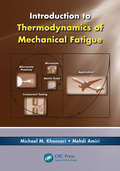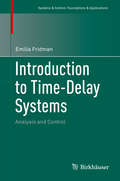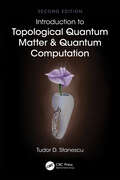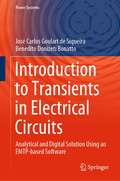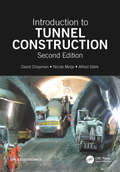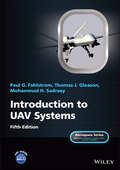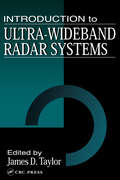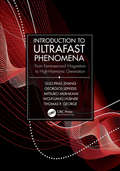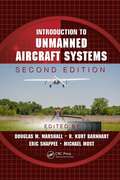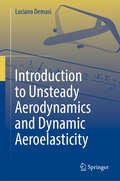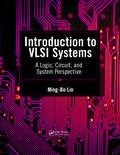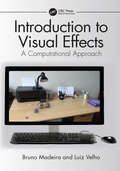- Table View
- List View
Introduction to Thermodynamics of Mechanical Fatigue
by Michael M. Khonsari Mehdi AmiriFatigue is probabilistic in nature and involves a complex spectrum of loading history with variable amplitudes and frequencies. Yet most available fatigue failure prediction methods are empirical and concentrate on very specific types of loading. Taking a different approach, Introduction to Thermodynamics of Mechanical Fatigue examines the treatmen
Introduction to Thin Film Transistors
by S. D. BrothertonIntroduction to Thin Film Transistors reviews the operation, application and technology of the main classes of thin film transistor (TFT) of current interest for large area electronics. The TFT materials covered include hydrogenated amorphous silicon (a-Si:H), poly-crystalline silicon (poly-Si), transparent amorphous oxide semiconductors (AOS), and organic semiconductors. The large scale manufacturing of a-Si:H TFTs forms the basis of the active matrix flat panel display industry. Poly-Si TFTs facilitate the integration of electronic circuits into portable active matrix liquid crystal displays, and are increasingly used in active matrix organic light emitting diode (AMOLED) displays for smart phones. The recently developed AOS TFTs are seen as an alternative option to poly-Si and a-Si:H for AMOLED TV and large AMLCD TV applications, respectively. The organic TFTs are regarded as a cost effective route into flexible electronics. As well as treating the highly divergent preparation and properties of these materials, the physics of the devices fabricated from them is also covered, with emphasis on performance features such as carrier mobility limitations, leakage currents and instability mechanisms. The thin film transistors implemented with these materials are the conventional, insulated gate field effect transistors, and a further chapter describes a new thin film transistor structure: the source gated transistor, SGT. The driving force behind much of the development of TFTs has been their application to AMLCDs, and there is a chapter dealing with the operation of these displays, as well as of AMOLED and electrophoretic displays. A discussion of TFT and pixel layout issues is also included. For students and new-comers to the field, introductory chapters deal with basic semiconductor surface physics, and with classical MOSFET operation. These topics are handled analytically, so that the underlying device physics is clearly revealed. These treatments are then used as a reference point, from which the impact of additional band-gap states on TFT behaviour can be readily appreciated. This reference book, covering all the major TFT technologies, will be of interest to a wide range of scientists and engineers in the large area electronics industry. It will also be a broad introduction for research students and other scientists entering the field, as well as providing an accessible and comprehensive overview for undergraduate and postgraduate teaching programmes.
Introduction to Time-Delay Systems
by Emilia FridmanThe beginning of the 21st century can be characterized as the" time-delay boom" leading to numerous important results. The purpose of this book is two-fold, to familiarize the non-expert reader with time-delay systems and to provide a systematic treatment of modern ideas and techniques for experts. This book is based on the course "Introduction to time-delay systems" for graduate students in Engineering and Applied Mathematics that the author taught in Tel Aviv University in 2011-2012 and 2012-2013 academic years. The sufficient background to follow most of the material are the undergraduate courses in mathematics and an introduction to control. The book leads the reader from some basic classical results on time-delay systems to recent developments on Lyapunov-based analysis and design with applications to the hot topics of sampled-data and network-based control. The objective is to provide useful tools that will allow the reader not only to apply the existing methods, but also to develop new ones. It should be of interest for researchers working in the field, for graduate students in engineering and applied mathematics, and for practicing engineers. It may also be used as a textbook for a graduate course on time-delay systems.
Introduction to Topological Defects and Solitons: In Liquid Crystals, Magnets, and Related Materials (Lecture Notes in Physics #1032)
by Jonathan V. SelingerThis textbook introduces topological defects and solitons at a level suitable for advanced undergraduates and beginning graduate students in physics and materials science. It avoids the formal mathematics of topology, and instead concentrates on the physical properties of these topological structures. The first half of the book concentrates on fundamental principles of defects and solitons, and illustrates these principles with a single example—the xy model for 2D magnetic order. It begins by defining the concept of a winding number, and uses this concept to describe the topology of defects (vortices or disclinations) and solitons (domain walls), carefully identifying the similarities and differences between these two types of topological structures. It then goes on to discuss physical properties of defects and solitons, including free energy, dynamics, statistical mechanics, and coupling with curvature. It shows how these concepts emerge from a theory with variable magnitude of order, and hence how topology can be viewed as an approximation to physics. The second half goes on to explore a wider range of topological defects and solitons. First, it considers more complex types of order—2D nematic liquid crystals, 3D magnetic or liquid-crystal order, 2D or 3D crystalline solids—and shows how each type of order leads to specific topological structures. Next, it discusses defects and solitons that are characterized by 2D or 3D measuring surfaces, not just 1D loops, including hedgehogs, skyrmions, and hopfions. These structures are more complex, but they can still be understood using the same fundamental principles. A final chapter describes the formation of phases with regular arrays of defects or solitons.
Introduction to Topological Quantum Matter & Quantum Computation
by Tudor D. StanescuWhat is "topological" about topological quantum states? How many types of topological quantum phases are there? What is a zero-energy Majorana mode, how can it be realized in a solid state system, and how can it be used as a platform for topological quantum computation? What is quantum computation and what makes it different from classical computation? Addressing these and other related questions, Introduction to Topological Quantum Matter & Quantum Computation provides an introduction to and a synthesis of a fascinating and rapidly expanding research field emerging at the crossroads of condensed matter physics, mathematics, and computer science. Providing the big picture, this book is ideal for graduate students and researchers entering this field as it allows for the fruitful transfer of paradigms and ideas amongst different areas, and includes many specific examples to help the reader understand abstract and sometimes challenging concepts. It explores the topological quantum world beyond the well-known topological insulators and superconductors and emphasizes the deep connections with quantum computation. It addresses key principles behind the classification of topological quantum phases and relevant mathematical concepts and discusses models of interacting and noninteracting topological systems, such as the torric code and the p-wave superconductor. The book also covers the basic properties of anyons, and aspects concerning the realization of topological states in solid state structures and cold atom systems. Quantum computation is also presented using a broad perspective, which includes fundamental aspects of quantum mechanics, such as Bell's theorem, basic concepts in the theory of computation, such as computational models and computational complexity, examples of quantum algorithms, and elements of classical and quantum information theory.
Introduction to Topological Quantum Matter & Quantum Computation
by Tudor D. StanescuWhat is "topological" about topological quantum states? How many types of topological quantum phases are there? What is a zero-energy Majorana mode, how can it be realized in a solid-state system, and how can it be used as a platform for topological quantum computation? What is quantum computation and what makes it different from classical computation?Addressing these and other related questions, Introduction to Topological Quantum Matter & Quantum Computation provides an introduction to and a synthesis of a fascinating and rapidly expanding research field emerging at the crossroads of condensed matter physics, mathematics, and computer science. Providing the big picture and emphasizing two major new paradigms in condensed matter physics – quantum topology and quantum information – this book is ideal for graduate students and researchers entering this field, as it allows for the fruitful transfer of ideas amongst different areas, and includes many specific examples to help the reader understand abstract and sometimes challenging concepts. It explores the topological quantum world beyond the well-known topological insulators and superconductors and unveils the deep connections with quantum computation. It addresses key principles behind the classification of topological quantum phases and relevant mathematical concepts and discusses models of interacting and noninteracting topological systems, such as the toric code and the p-wave superconductor. The book also covers the basic properties of anyons, and aspects concerning the realization of topological states in solid state structures and cold atom systems.Topological quantum computation is also presented using a broad perspective, which includes elements of classical and quantum information theory, basic concepts in the theory of computation, such as computational models and computational complexity, examples of quantum algorithms, and key ideas underlying quantum computation with anyons. This new edition has been updated throughout, with exciting new discussions on crystalline topological phases, including higher-order topological insulators; gapless topological phases, including Weyl semimetals; periodically-driven topological insulators; and a discussion of axion electrodynamics in topological materials.Key Features:· Provides an accessible introduction to this exciting, cross-disciplinary area of research.· Fully updated throughout with new content on the latest result from the field.· Authored by an authority on the subject.Tudor Stanescu is a professor of Condensed Matter Theory at West Virginia University, USA. He received a B.S. in Physics from the University of Bucharest, Romania, in 1994 and a Ph.D. in Theoretical Physics from the University of Illinois at Urbana Champaign in 2002. He was a Postdoctoral Fellow at Rutgers University and at the University of Maryland from 2003 to 2009. He joined the Department of Physics and Astronomy at West Virginia University in Fall 2009. Prof. Stanescu’s research interests encompass a variety of topics in theoretical condensed matter physics including topological insulators and superconductors, topological quantum computation, ultra-cold atom systems in optical lattices, and strongly correlated materials, such as, for example, cuprate high-temperature superconductors. His research uses a combination of analytical and numerical tools and focuses on understanding the emergence of exotic states of matter in solid state and cold atom structures, for example, topological superconducting phases that host Majorana zero modes, and on investigating the possibilities of exploiting these states as physical platforms for quantum computation.
Introduction to Toxicology and Food
by Tomris AltugWith growing interest in the safety of foods, knowledge of food toxicology is gaining more importance every day. Introduction to Toxicology and Food provides a concise overview of both the science of toxicology and food toxicology. It presents easy-to-understand explanations of the concepts and principles of toxicology as a science, the toxicants f
Introduction to Transients in Electrical Circuits: Analytical and Digital Solution Using an EMTP-based Software (Power Systems)
by Benedito Donizeti Bonatto José Carlos Goulart de SiqueiraThis book integrates analytical and digital solutions through Alternative Transients Program (ATP) software, recognized for its use all over the world in academia and in the electric power industry, utilizing a didactic approach appropriate for graduate students and industry professionals alike.This book presents an approach to solving singular-function differential equations representing the transient and steady-state dynamics of a circuit in a structured manner, and without the need for physical reasoning to set initial conditions to zero plus (0+). It also provides, for each problem presented, the exact analytical solution as well as the corresponding digital solution through a computer program based on the Electromagnetics Transients Program (EMTP).Of interest to undergraduate and graduate students, as well as industry practitioners, this book fills the gap between classic works in the field of electrical circuits and more advanced works in the field of transients in electrical power systems, facilitating a full understanding of digital and analytical modeling and solution of transients in basic circuits.
Introduction to Tribology
by Bharat BhushanA fully updated version of the popular Introduction to Tribology, the second edition of this leading tribology text introduces the major developments in the understanding and interpretation of friction, wear and lubrication. Considerations of friction and wear have been fully revised to include recent analysis and data work, and friction mechanisms have been reappraised in light of current developments. In this edition, the breakthroughs in tribology at the nano- and micro- level as well as recent developments in nanotechnology and magnetic storage technologies are introduced. A new chapter on the emerging field of green tribology and biomimetics is included. Introduces the topic of tribology from a mechanical engineering, mechanics and materials science points of viewNewly updated chapter covers both the underlying theory and the current applications of tribology to industryUpdated write-up on nanotribology and nanotechnology and introduction of a new chapter on green tribology and biomimeticsEnables readers to reinforce their knowledge of the topic with a newly added problems section which features on the book's companion website
Introduction to Tsallis Entropy Theory in Water Engineering
by Vijay P. SinghFocuses On an Emerging Field in Water EngineeringA broad treatment of the Tsallis entropy theory presented from a water resources engineering point of view, Introduction to Tsallis Entropy Theory in Water Engineering fills a growing need for material on this theory and its relevant applications in the area of water engineering. This self-contained
Introduction to Tunnel Construction
by Nicole Metje David Chapman Alfred StärkTunnelling provides a robust solution to a variety of engineering challenges. It is a complex process, which requires a firm understanding of the ground conditions as well as structural issues. This book covers the whole range of areas that you need to know in order to embark upon a career in tunnelling. It also includes a number of case studies of real tunnel projects, to demonstrate how the theory applies in practice. The coverage includes: Both hard-rock and soft-ground conditions Site investigation, parameter selection, and design considerations Methods of improving the stability of the ground and lining techniques Descriptions of the various tunnelling techniques Health and safety considerations Monitoring of tunnels during construction Clear, concise, and heavily illustrated, this is a vital text for final-year undergraduate and MSc students and an invaluable starting point for young professionals.
Introduction to Tunnel Construction (Applied Geotechnics Ser.)
by David N. Chapman Nicole Metje Alfred StarkTunnelling provides a robust solution to a variety of engineering challenges. It is a complex process, which requires a firm understanding of the ground conditions as well as the importance of ground-structure interaction. This book covers the full range of areas related to tunnel construction required to embark upon a career in tunnelling. It also includes a number of case studies related to real tunnel projects, to demonstrate how the theory applies in practice. New features of this second edition include: the introduction of a case study related to Crossrail’s project in London, focussing on the Whitechapel and Liverpool Street station tunnels and including considerations of building tunnels in a congested urban area; and further information on recent developments in tunnel boring machines, including further examples of all the different types of machine as well as multi-mode machines. The coverage includes: Both hard-rock and soft-ground conditions Site investigation, parameter selection, and design considerations Methods of improving the stability of the ground and lining techniques Descriptions of the various main tunnelling techniques Health and safety considerations Monitoring of tunnels during construction Description of the latest tunnel boring machines Case studies with real examples, including Crossrail’s project in London Clear, concise, and heavily illustrated, this is a vital text for final-year undergraduate and MSc students and an invaluable starting point for young professionals and novices in tunnelling.
Introduction to UAV Systems
by Paul Gerin Fahlstrom Thomas James GleasonUnmanned aerial vehicles (UAVs) have been widely adopted in the military world over the last decade and the success of these military applications is increasingly driving efforts to establish unmanned aircraft in non-military roles. Introduction to UAV Systems, 4th edition provides a comprehensive introduction to all of the elements of a complete Unmanned Aircraft System (UAS). It addresses the air vehicle, mission planning and control, several types of mission payloads, data links and how they interact with mission performance, and launch and recovery concepts. This book provides enough information to encourage a student to learn more; to provide a specialist with a basic appreciation of the technical issues that drive other parts of the system and interact with their specialty; or to help a program manager understand system-level tradeoffs and know what questions to ask. Key features: Comprehensive overview of all elements of a UAS and of how they interact. Introduces the underlying concepts of key subsystems. Emphasizes system-integration issues and how they relate to subsystem design choices. Practical discussion of issues informed by lessons learned in UAV programs. Introduction to UAV Systems, 4th edition is written both for newcomers to the subject and for experienced members of the UAV community who desire a comprehensive overview at the system level. As well as being a primary text for an introductory course on UAS or a supplementary text in a course that goes into more depth in one of the individual technologies involved in a UAS, this book is a useful overview for practicing engineers, researchers, managers, and consultants interested in UAV systems.
Introduction to UAV Systems (Aerospace Series)
by Mohammad H. Sadraey Paul G. Fahlstrom Thomas J. GleasonIntroduction to UAV Systems The latest edition of the leading resource on unmanned aerial vehicle systems In the newly revised Fifth Edition of Introduction to UAV Systems, an expert team of aviators, engineers, and researchers delivers the fundamentals of UAV systems for both professionals and students in UAV courses. Suitable for students in Aerospace Engineering programs, as well as Flight and Aeronautics programs, this new edition now includes end-of-chapter questions and online instructor ancillaries that make it an ideal textbook. As the perfect complement to the author’s Design of Unmanned Aerial Systems, this book includes the history, classes, and missions of UAVs. It covers fundamental topics, like aerodynamics, stability and control, propulsion, loads and structures, mission planning, payloads, and communication systems. Brand-new materials in areas including autopilots, quadcopters, payloads, and ground control stations highlight the latest industry technologies. The authors also discuss: A thorough introduction to the history of unmanned aerial vehicles, including their use in various conflicts, an overview of critical UAV systems, and the Predator/Reaper A comprehensive exploration of the classes and missions of UAVs, including several examples of UAV systems, like Mini UAVs, UCAVs, and quadcopters Practical discussions of air vehicles, including coverage of topics like aerodynamics, flight performance, stability, and control In-depth examinations of propulsion, loads, structures, mission planning, control systems, and autonomy Perfect for professional aeronautical and aerospace engineers, as well as students and instructors in courses like Unmanned Aircraft Systems Design and Introduction to Unmanned Aerial Systems, Introduction to UAV Systems is an indispensable resource for anyone seeking coverage of the latest industry advances and technologies in UAV and UAS technology.
Introduction to Ultra-Wideband Radar Systems
by James D. TaylorThis introductory reference covers the technology and concepts of ultra-wideband (UWB) radar systems. It provides up-to-date information for those who design, evaluate, analyze, or use UWB technology for any application. Since UWB technology is a developing field, the authors have stressed theory and hardware and have presented basic principles and concepts to help guide the design of UWB systems. Introduction to Ultra-Wideband Radar Systems is a comprehensive guide to the general features of UWB technology as well as a source for more detailed information.
Introduction to Ultrafast Phenomena: From Femtosecond Magnetism to High-Harmonic Generation
by Thomas F. George Wolfgang Hübner Guo-ping Zhang Georgios Lefkidis Mitsuko MurakamiThis book, the first of this kind, provides a comprehensive introduction to ultrafast phenomena, covering the fundamentals of ultrafast spin and charge dynamics, femtosecond magnetism, all-optical spin switching, and high-harmonic generation. It covers the experimental tools, including ultrafast pump-probe experiments, and theoretical methods including quantum chemistry and density functional theory, both time-independent and time-dependent. The authors explain in clear language how an ultrafast laser pulse is generated experimentally, how it can induce rapid responses in electrons and spins in molecules, nanostructures and solids (magnetic materials and superconductors), and how it can create high-harmonic generation from atoms and solids on the attosecond timescale. They also show how this field is driving the next generation of magnetic storage devices through femtomagnetism, all-optical spin switching in ferrimagnets and beyond, magnetic logic in magnetic molecules, and ultrafast intense light sources, incorporating numerous computer programs, examples, and problems throughout, to show how the beautiful research can be done behind the scene. Key features: · Provides a clear introduction to modern ultrafast phenomena and their applications in physics, chemistry, materials sciences, and engineering. · Presents in detail how high-harmonic generation occurs in atoms and solids. · Explains ultrafast demagnetization and spin switching, a new frontier for development of faster magnetic storage devices. · Includes numerous worked-out examples and problems in each chapter, with real research codes in density functional theory and quantum chemical calculations provided in the chapters and in the Appendices. This book is intended for undergraduate and graduate students, researchers in physics, chemistry, biology, materials sciences, and engineering.
Introduction to Unified Mechanics Theory with Applications
by Cemal BasaranThis second edition adds new sections on derivation of dynamic equilibrium equations in unified mechanics theory and solution of an example, derivation of very high cycle fatigue thermodynamic fundamental equation and application/verification with two metal fatigue examples, derivation of thermodynamic fundamental equations for metal corrosion, examples of corrosion – fatigue interaction. There is also an example of ultrasonic vibration fatigue and one traditional tension/compression loading in elastic regime. While updated and augmented throughout, the book retains its description of the mathematical formulation and proof of the unified mechanics theory (UMT), which is based on the unification of Newton’s laws and the laws of thermodynamics. It also presents formulations and experimental verifications of the theory for thermal, mechanical, electrical, corrosion, chemical and fatigue loads, and it discusses why the original universal laws of motion proposed by Isaac Newton in 1687 are incomplete. The author provides concrete examples, such as how Newton’s second law, F = ma, gives the initial acceleration of a soccer ball kicked by a player, but does not tell us how and when the ball would come to a stop. Over the course of the text, Dr. Basaran illustrates that Newtonian mechanics does not account for the thermodynamic changes happening in a system over its usable lifetime. And in this context, this book explains how to design a system to perform its intended functions safely over its usable life time and predicts the expected lifetime of the system without using empirical models, a process currently done using Newtonian mechanics and empirical degradation/failure/fatigue models which are curve-fit to test data. Written as a textbook suitable for upper-level undergraduate mechanics courses, as well as first year graduate level courses, this book is the result of over 25 years of scientific activity with the contribution of dozens of scientists from around the world.
Introduction to Unified Strength Theory
by Mao-Hong Yu Shu-Qi YuStrength theory deals with the yield or failure of materials under complex stress state. It is very important in mechanics of materials, strength of structures, and mechanical and civil engineering. Unified strength theory is a series of yield criteria and failure criteria other than a single strength theory. <P><P>The unified strength theory can be adopted for various kinds of materials, such as metallic materials, geomaterials, polymers etc. It is the solution to the Voigt-Timoshenko Conundrum. Its limit surfaces cover all regions of the convex strength theory from the lower bound to the upper bound. This book gives a clear and brief description about the unified strength theory both in figures and text. Some applications of unified strength theory are also given in this book. This book is suitable for undergraduate students, who are studying the mechanics of materials and engineering mechanics, as well as for graduate students who are interested in this field. Researchers and engineers can also benefit from this book.
Introduction to Unmanned Aircraft Systems
by Douglas M. Marshall Eric Shappee R. Kurt Barnhart Michael MostIntroduction to Unmanned Aircraft Systems surveys the fundamentals of unmanned aircraft system (UAS) operations, from sensors, controls, and automation to regulations, safety procedures, and human factors. It is designed for the student or layperson and thus assumes no prior knowledge of UASs, engineering, or aeronautics. Dynamic and well-illustrated, the first edition of this popular primer was created in response to a need for a suitable university-level textbook on the subject. Fully updated and significantly expanded, this new Second Edition: Reflects the proliferation of technological capability, miniaturization, and demand for aerial intelligence in a post-9/11 world Presents the latest major commercial uses of UASs and unmanned aerial vehicles (UAVs) Enhances its coverage with greater depth and support for more advanced coursework Provides material appropriate for introductory UAS coursework in both aviation and aerospace engineering programs Introduction to Unmanned Aircraft Systems, Second Edition capitalizes on the expertise of contributing authors to instill a practical, up-to-date understanding of what it takes to safely operate UASs in the National Airspace System (NAS). Complete with end-of-chapter discussion questions, this book makes an ideal textbook for a first course in UAS operations.
Introduction to Unmanned Aircraft Systems
by R. Kurt BarnhartIntroduction to Unmanned Aircraft Systems, Third Edition surveys the basics of unmanned aircraft systems (UAS), from sensors, controls, and automation to regulations, safety procedures, and human factors. Featuring chapters by leading experts, this fully updated bestseller fills the need for an accessible and effective university textbook. Focussing on the civilian applications of UAS, the text begins with an historical overview of unmanned aerial vehicles, and proceeds to examine each major UAS subsystem. Its combination of understandable technical coverage and up-to-date information on policy and regulation makes the text appropriate for both Aerospace Engineering and Aviation programs.
Introduction to Unsteady Aerodynamics and Dynamic Aeroelasticity
by Luciano DemasiAeroelasticity is an essential discipline for the design of airplanes, unmanned systems, and innovative configurations. This book introduces the subject of unsteady aerodynamics and dynamic aeroelasticity by presenting industry-standard techniques, such as the Doublet Lattice Method for nonplanar wing systems. “Introduction to Unsteady Aerodynamics and Dynamic Aeroelasticity'' is a useful reference for aerospace engineers and users of NASTRAN and ZAERO but is also an excellent complementary textbook for senior undergraduate and graduate students. The theoretical material includes: · Fundamental equations of aerodynamics. · Concepts of Velocity and Acceleration Potentials. · Theory of small perturbations. · Virtual displacements and work, Hamilton's Principle, and Lagrange's Equations. · Aeroelastic equations expressed in the time, Laplace, and Fourier domains. · Concept of Generalized Aerodynamic Force Matrix. · Complete derivation of the nonplanar kernel for unsteady aerodynamic analyses. · Detailed derivation of the Doublet Lattice Method. · Linear Time-Invariant systems and stability analysis. · Rational function approximation for the generalized aerodynamic force matrix. · Fluid-structure boundary conditions and splining. · Root locus technique. · Techniques to find the flutter point: k, k-E, p-k, non-iterative p-k, g, second-order g, GAAM, p, p-L, p-p, and CV methods.
Introduction to Urban Water Distribution: Unesco-IHE Lecture Note Series (Ihe Delft Lecture Note Ser.)
by Nemanja TrifunovicFocusing primarily on understanding the steady-state hydraulics that form the basis of hydraulic design and computer modelling applied in water distribution, Introduction to Urban Water Distribution elaborates the general principles and practices of water distribution in a straightforward way. The workshop problems and design exercise develop a tem
Introduction to VLSI Systems: A Logic, Circuit, and System Perspective
by Ming-Bo LinWith the advance of semiconductors and ubiquitous computing, the use of system-on-a-chip (SoC) has become an essential technique to reduce product cost. With this progress and continuous reduction of feature sizes, and the development of very large-scale integration (VLSI) circuits, addressing the harder problems requires fundamental understanding
Introduction to Visual Computing: Core Concepts in Computer Vision, Graphics, and Image Processing
by Aditi Majumder M. GopiIntroduction to Visual Computing: Core Concepts in Computer Vision, Graphics, and Image Processing covers the fundamental concepts of visual computing. Whereas past books have treated these concepts within the context of specific fields such as computer graphics, computer vision or image processing, this book offers a unified view of these core concepts, thereby providing a unified treatment of computational and mathematical methods for creating, capturing, analyzing and manipulating visual data (e.g. 2D images, 3D models). Fundamentals covered in the book include convolution, Fourier transform, filters, geometric transformations, epipolar geometry, 3D reconstruction, color and the image synthesis pipeline. The book is organized in four parts. The first part provides an exposure to different kinds of visual data (e.g. 2D images, videos and 3D geometry) and the core mathematical techniques that are required for their processing (e.g. interpolation and linear regression.) The second part of the book on Image Based Visual Computing deals with several fundamental techniques to process 2D images (e.g. convolution, spectral analysis and feature detection) and corresponds to the low level retinal image processing that happens in the eye in the human visual system pathway. The next part of the book on Geometric Visual Computing deals with the fundamental techniques used to combine the geometric information from multiple eyes creating a 3D interpretation of the object and world around us (e.g. transformations, projective and epipolar geometry, and 3D reconstruction). This corresponds to the higher level processing that happens in the brain combining information from both the eyes thereby helping us to navigate through the 3D world around us. The last two parts of the book cover Radiometric Visual Computing and Visual Content Synthesis. These parts focus on the fundamental techniques for processing information arising from the interaction of light with objects around us, as well as the fundamentals of creating virtual computer generated worlds that mimic all the processing presented in the prior sections. The book is written for a 16 week long semester course and can be used for both undergraduate and graduate teaching, as well as a reference for professionals.
Introduction to Visual Effects: A Computational Approach
by Luiz Velho Bruno MadeiraIntroduction to Visual Effects: A Computational Approach is the first single introduction to the computational and mathematical aspects of visual effects, incorporating both computer vision and graphics. The book also provides the readers with the source code to a library, enabling them to follow the chapters directly and build up a complete visual effects platform. The book covers the basic approaches to camera pose estimation, global illumination, and image-based lighting, and includes chapters on the virtual camera, optimization and computer vision, path tracing and many more. Key features include: Introduction to projective geometry, image-based lighting (IBL), global illumination solved by the Monte Carlo method (Pathtracing), an explanation of a set of optimization methods, and the techniques used for calibrating one, two, and many cameras, including how to use the RANSAC algorithm in order to make the process robust, and providing code to be implemented using the Gnu Scientific Library. C/C++ code using the OpenCV library, to be used in the process of tracking points on a movie (an important step for the matchmove process), and in the construction of modeling tools for visual effects. A simple model of the Bidirectional Reflectance Distribution Function (BRDF) of surfaces and the differential rendering method, allowing the reader to generate consistent shadows, supported by a code that can be used in combination with a software like Luminance HDR.
